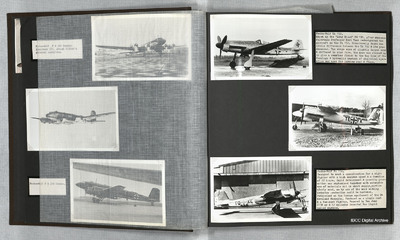Focke-Wulf TA 152 and TA 154
Title
Focke-Wulf TA 152 and TA 154
Description
Photo 1 is a TA 152, also known as the long nosed Fw 190. It is seen from the port side and its tail is raised on a small ramp.
Photo 2 and 3 are of the TA 154 seen from the port then starboard sides.
Photo 2 and 3 are of the TA 154 seen from the port then starboard sides.
Coverage
Language
Type
Format
Three b/w photographs on an album page
Publisher
Rights
This content is available under a CC BY-NC 4.0 International license (Creative Commons Attribution-NonCommercial 4.0). It has been published ‘as is’ and may contain inaccuracies or culturally inappropriate references that do not necessarily reflect the official policy or position of the University of Lincoln or the International Bomber Command Centre. For more information, visit https://creativecommons.org/licenses/by-nc/4.0/ and https://ibccdigitalarchive.lincoln.ac.uk/omeka/legal.
Identifier
PThomasAF20070004
Transcription
[Photograph]
Focke-Wulf TA 152.
Known as the ‘Long Nosed’ FW 190. After successful trials Professor Kurt Tank redesignated the aircraft as the TA 152. Structurally there was little difference between the TA 152 & its predecessor. The wings were of slightly larger area & differed in plan form, the nose was cleaned up to give a smoother finish to the top line of the fuselage & hydraulic instead of electrical operation was used for landing gear & flaps.
[Photograph]
[Photograph]
Focke-Wulf TA 154.
Designed to meet a specification for a night fighter with a high maximum speed & a duration of 2 3/4 hours. Rapid development & quantity production was emphasised together with extensive use of materials not in short supply, particularly wood, as by use of the wood working industry -roduction [sic] could be hastened. Publicised as the German equivalent of the De Havilland Mosquito. Produced as a single seat & a two-seat fighter. Powered by Two Jumo 211N or R 12 cylinder inverted Vee liquid cooled engines.
Focke-Wulf TA 152.
Known as the ‘Long Nosed’ FW 190. After successful trials Professor Kurt Tank redesignated the aircraft as the TA 152. Structurally there was little difference between the TA 152 & its predecessor. The wings were of slightly larger area & differed in plan form, the nose was cleaned up to give a smoother finish to the top line of the fuselage & hydraulic instead of electrical operation was used for landing gear & flaps.
[Photograph]
[Photograph]
Focke-Wulf TA 154.
Designed to meet a specification for a night fighter with a high maximum speed & a duration of 2 3/4 hours. Rapid development & quantity production was emphasised together with extensive use of materials not in short supply, particularly wood, as by use of the wood working industry -roduction [sic] could be hastened. Publicised as the German equivalent of the De Havilland Mosquito. Produced as a single seat & a two-seat fighter. Powered by Two Jumo 211N or R 12 cylinder inverted Vee liquid cooled engines.
Collection
Citation
“Focke-Wulf TA 152 and TA 154,” IBCC Digital Archive, accessed November 8, 2024, https://ibccdigitalarchive.lincoln.ac.uk/omeka/collections/document/23193.
Item Relations
This item has no relations.

